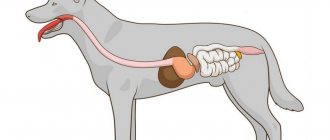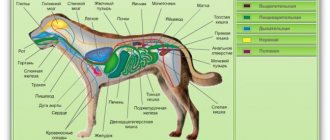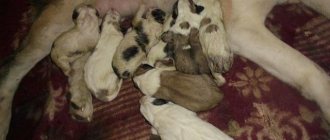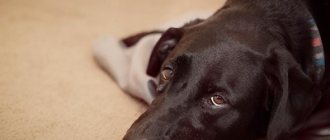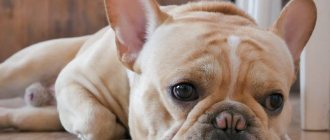Many owners consider a dog’s nose to be an indicator of the pet’s health, and the slightest discharge from it indicates the development of pathology in the respiratory system. The owner may observe greenish discharge from the nose of his four-legged friend due to inflammation of the maxillary sinuses (sinusitis). The disease requires qualified help to avoid serious complications.
Causes of purulent discharge
According to veterinary experts, the most common reasons for the discharge of purulent exudate from a dog’s nose are:
- Allergy
Chronic rhinitis. Inflammatory processes in the nasal mucosa can lead to the spread of infection into the sinuses. Often the cause of sinusitis is ineffective treatment of bronchitis and bronchopneumonia. - Head injuries associated with damage to the nasal septum.
- Allergic reaction. Under the influence of one or another allergen, irritation of the mucous membrane and epithelium lining the maxillary sinuses occurs. Swollen tissues are quickly exposed to pathogenic microflora.
- Dental problems. Dental diseases (tooth root abscess), gingivitis, ulcers and inflammatory processes in the oral cavity can provoke infection in the maxillary paranasal sinuses.
- Neoplasms in the nasal cavity. Polyps and tumors of various etiologies block the lumen of the nasal concha, which is a common cause of sinusitis in dogs.
- Foreign body in the nasal cavity. Naturally curious pets can accidentally inhale foreign objects in the stream of inhaled air - small parts from children's toys, buttons, plant seeds, etc.
- Abnormal development of the cartilaginous structures of the nasal sinuses.
- Inhalation of toxic fumes. In some cases, keeping a pet in a smoky room can lead to inflammation of the nasal sinuses.
- In rare cases, pathogenic microorganisms can be introduced into the maxillary sinuses through the bloodstream from other organs and tissues.
Veterinarians and experienced dog breeders in some cases consider hypothermia to be the cause of purulent nasal discharge. The provoking factor in the development of pathology is the body’s low resistance to pathogens and weakened immunity as a result of chronic diseases.
According to veterinarians, sinusitis is more common in dogs with a brachycephalic skull structure (bulldogs, pugs). This phenomenon is associated with the peculiarities of the anatomical structure. Shortened nasal passages are a favorable environment for the development of congestive and inflammatory processes in the maxillary sinuses.
We recommend reading about colds in dogs. You will learn about the symptoms of the disease, treatment with antibiotics and folk remedies, and prevention.
Find out more about fever in dogs here.
Symptoms of sinusitis in dogs and other diseases
An irritating agent (microorganisms, poisons, foreign body, allergen) causes swelling of the mucous membrane of the nasal passages. The mucus produced by epithelial cells leads to a narrowing of the lumen of the maxillary sinuses, which is accompanied by inflammation and pain. An owner can suspect his four-legged friend has sinusitis if he knows the symptoms of the disease:
- At the beginning of the development of the disease, clear discharge from the nasal cavity is noted. As inflammation develops, their color changes to white, then the exudate becomes purulent (yellow-green or creamy). It is often possible to observe blood impurities due to fragility of blood vessels.
- The animal often licks off secretions with its tongue, sneezes, and rubs its nose with its paws. Dried crusts are observed on the nasal planum, and in some cases the nasal mucosa becomes ulcerated.
- Due to nasal congestion, the pet cannot breathe freely. Inhalation and exhalation is done through an open mouth. Breathing is noisy.
- Lethargic state, the dog sleeps a lot, is reluctant to go for walks, refuses active games.
- During sleep, snoring and noisy breathing are observed due to swelling of the nasal sinuses.
- The accumulation of pus in the maxillary sinuses causes severe pain in the pet, which is manifested by a cautious gait. The dog avoids sudden movements and may whine in pain when sneezing.
- Submandibular lymph nodes often enlarge to the size of a chicken egg. Lymphadenitis develops as a result of infection entering the lymphatic system.
- In severe cases of sinusitis, the animal has head asymmetry. The owner can observe unilateral drooping of the cheek, ear, and eye.
- In some cases, conjunctivitis is possible.
A sick pet loses its appetite. With sinusitis due to the inflammatory process, an increase in body temperature to 40 - 41C is observed.
Helping your pet before visiting the clinic
- Cover your dog's eyes with your palm and shine a flashlight into his nose. Carefully examine the mucous membranes (is there any swelling, redness, or narrowed nasal passages). We have already written above what to do if a runny nose appears due to a foreign body stuck in the nostril. But what you shouldn’t do is try to wash a stuck object with a jet or drip, even carefully, drops into the spout (the danger is the same - you can push the debris even deeper);
- remove all dirt around the nostrils and from the mirror of the nose with a gauze swab dipped in lukewarm water or chamomile infusion;
- drip anandin or maxidin solution (0.15%), 1-2 drops into each nostril of a small dog and 3 drops if the dog weighs more than 40 kg. These are complex drops that are active against bacteria and viruses, relieve swelling and inflammation, accelerate tissue healing - the drugs are soft and safe. Repeat 2-3 times a day, remembering to first clear the nose of exudate;
Many owners consider a dog’s nose to be an indicator of the pet’s health, and the slightest discharge from it indicates the development of pathology in the respiratory system. The owner may observe greenish discharge from the nose of his four-legged friend due to inflammation of the maxillary sinuses (sinusitis). The disease requires qualified help to avoid serious complications.
Read in this article
Diagnosis of an animal
First of all, it is important for the owner to make sure that the cause of purulent nasal discharge in the pet is sinusitis, and not an infectious disease such as canine distemper. A viral infection, as a rule, is accompanied not only by symptoms of purulent sinusitis, but also by diarrhea, vomiting, and severe dehydration. If such a clinical picture is present, the owner should immediately seek qualified help.
After collecting an anamnesis and conducting a general clinical examination, the veterinary specialist prescribes a series of studies. First of all, a laboratory study of the washout from the nasal mucosa is carried out. Bacteriological analysis allows you to determine the causative agent of the infection and select the most effective antibacterial drug.
Clinical blood examination allows you to clarify the diagnosis. With sinusitis, leukocytosis and an increased content of lymphocytes are observed.
X-ray examination helps to reliably judge inflammation of the maxillary sinuses in an animal. X-rays are taken in frontal and lateral projections, the animal’s mouth should be open. In the image, an experienced veterinary radiologist will see areas of darkening, which indicate that the nasal sinuses are filled with purulent contents.
An X-ray examination will detect a foreign body in the nasal cavity, an anomaly in the development of the skull, neoplasms, and polyps.
Differential diagnosis is carried out primarily in relation to infectious diseases - canine distemper, adenovirus infection. Sinusitis, frontal sinusitis, and neoplastic causes of sinusitis are excluded.
Treatment of pus from the nose in dogs
Treatment of the disease begins with the procedure of freeing the nasal cavity from crusts and exudate. For this purpose, the pet’s nose is treated with antiseptic solutions - Miramistin, chlorhexidine, furatsilin. Infusions of medicinal plants that have anti-inflammatory and calming effects - calendula, chamomile, sage - are also suitable.
After the nose is freed from crusts and pus, the animal's sinuses are washed with saline. At home, it is convenient to use a syringe for the procedure. The use of medicinal drops, for example Anandin, has a good therapeutic effect.
The use of human drops with a vasoconstrictor effect, such as Naphthyzin and Sanorin, is prohibited for dogs. Such drugs dry out the mucous membrane and provoke even greater swelling. Traditional medicine uses propolis solution and sea buckthorn oil.
Inhalation has a good effect on a sick pet. For this purpose, essential oils of eucalyptus, tea tree are used, or pine twigs are brewed. During the procedure, you must ensure that the steam is not too hot.
It is useful to use dry heat in the form of a Sollux lamp. Fabric bags with heated table salt can be applied to the bridge of the nose of a sick animal.
In addition to local effects on the source of inflammation, systemic use of antibacterial agents is indicated for sinusitis.
Antibiotics of the penicillin series, for example Bicillin-5, are highly effective in treating the disease. Cephalosporins, such as Ceftriaxone, are also used in veterinary practice. The drug is administered intramuscularly at a dose recommended by the attending physician. The duration of the course is at least 10 days. In advanced cases, antibacterial therapy is extended to 14–21 days.
In order to increase the body's defenses, the course of treatment includes immunomodulators, vitamins and mineral supplements. It is recommended that the diet be composed of easily digestible foods. Walking during treatment is reduced to avoid hypothermia.
Therapy
Thus, treatment of rhinitis in dogs always depends on its underlying cause. First, we will consider therapy for fungal forms of the inflammatory process, since in these cases it is most difficult to achieve a complete recovery of the dog.
Topical application of enilconazole
by rinsing the nasal cavity and sinuses through a catheter shows approximately 90% effectiveness.
Of course, it is difficult to classify this procedure as simple. Catheters are surgically threaded into the sinuses after trephination. Naturally, the procedure is performed exclusively under anesthesia. Enilconazole is used twice daily at a dosage of 10 mg/kg for 7-10 days. Difficulties may arise if during subsequent flushes (when anesthesia is no longer required) the dog twitches, causing the catheters to come out of the sinuses prematurely. This is fraught with the development of subcutaneous emphysema, hypersalivation (the dog is constantly drooling), and deterioration of appetite. Many dogs have an extremely negative attitude towards frequent washing, becoming very nervous and aggressive. Therefore, it is better to treat a large dog with clotrimazole.
In this case, you also cannot do without catheters, but the method of their use is much more “humane” and does not involve trepanation of the cranial sinuses. 60 ml of a 1% solution of the drug is slowly poured through catheters placed in both nostrils.
A nasopharyngeal Foley catheter and sponges placed in the posterior pharyngeal region are always used to prevent the dog from choking. Every 15 minutes, the animal’s head is carefully turned to the right and left in order to ensure the best possible distribution of the medicinal substance. It is reported that in 90% of cases, just one procedure is enough for complete recovery, although some dogs need to repeat the flush after three weeks. Unfortunately, in this case, side effects are possible, including pharyngitis and/or severe laryngeal edema.
Other Treatment Options
What medications are used to treat allergic rhinitis? It is believed that in most cases it is enough to completely isolate the dog from the effects of allergens, after which the disease should subside. But this scenario looks very utopian, which is due to the difficulty of identifying allergens (not every clinic can do this). Despite a considerable amount of information in the specialized literature, systemic corticosteroids
often not only do not alleviate the condition of a sick pet, but can also lead to a worsening of clinical signs. Therefore, their use in most cases should be avoided in every possible way.
But this warning is not relevant in all cases. So, for chronic rhinitis, they can be very useful if the products are used by spraying them through an inhaler. Oddly enough, for allergic rhinitis, antihistamines rarely show high effectiveness
. More often they are used only to reduce the volume of exudate released. Such remedies are convenient when treatment is carried out at home, but severe types of pathology cannot be cured with their help.
Regarding antibiotics
. They are (in most cases) the basis for the treatment of many types of rhinitis, since the development of pathogenic microflora in any type of this disease is almost always observed. Sometimes it is recommended to prescribe antibacterial agents in conjunction with anti-inflammatory corticosteroids, since their effectiveness in such situations increases. Again, this treatment approach is often recommended in the setting of chronic rhinitis.
Doxycycline or azithromycin in combination with piroxicam showed the best results.
If the drugs are prescribed for two weeks or more, the daily dose of piroxicam remains unchanged, but the frequency of doxycycline is reduced to once a day. As for azithromycin, in this situation it is generally administered twice a week.
Note that in severe cases, worsened by the development of fungal microflora, complete recovery may require three to four months! In short, you should not delay contacting the veterinarian.
Prevention
To prevent such a nuisance in your pet as sinusitis, following the following recommendations from veterinary specialists will help:
- Balanced diet. Adequate nutrition is the key to the formation of a strong animal’s immune system.
- Protection against hypothermia. The pet should be kept in a warm, dry and draft-free room. It is unacceptable for your dog to inhale tobacco smoke.
- Prevention of skull injuries and foreign objects entering the nasal passages.
- Timely treatment of respiratory diseases (rhinitis, bronchitis, bronchopneumonia).
- Competent treatment of allergies in animals.
We recommend reading about runny nose in dogs. You will learn about the causes of runny nose in dogs, symptoms, treatment of runny nose at home, drops for a stuffy nose.
And here is more information about rhinitis in dogs and cats.
Sinusitis in dogs is an inflammation involving the maxillary sinuses. There are many reasons for the pathology - from banal hypothermia to neoplastic processes. Purulent nasal discharge should be differentiated from infectious diseases - plague, adenovirus. Therapy is complex and includes local treatment and a course of broad-spectrum antibiotics.
Useful video
For more information on the causes and treatment of runny nose in dogs, watch this video:
Similar articles
- Rhinitis in Dogs and Cats: Symptoms and Treatment
Rhinitis (runny nose) is a very common disease among dogs and cats. .serp-item__passage{color:#888}… Inflammation of the nasal mucosa is observed, which is accompanied by the discharge of mucus from the nose (colorless, greenish or… Read more - Runny nose in a dog: causes in small breeds, how to cure...
Due to bad weather, as well as other reasons, your dog may develop a runny nose. For example, it occurs more often in small breeds. It is not always possible to cure a runny nose, cough and sneezing at home; nasal drops can… Read more
- Otitis in a dog (purulent, allergic, fungal...)
Otitis media occurs in dogs due to various reasons. It can be purulent, allergic, fungal, and also turn from acute to chronic. Symptoms are most often noticeable by itching and discharge. Read more
- Colds in dogs: can they get infected, symptoms, what...
Serous discharge from the nasal cavity. The exudate is usually transparent, without any admixture of pus, blood or foamy discharge. ... If the dog does not breathe through its nose, then inhalations are performed to eliminate congestion. Read more
- A purulent wound in a dog: how to treat it at home, treatment...
A dog has a purulent wound: how to help your pet? ... The devices are made of rubber or vinyl chloride. Thanks to drainage, pus is removed from the wound. Read more
Treatment of rhinitis at home
At the first signs of illness, the dog should be shown to a veterinarian, who will conduct an examination and prescribe the necessary medications. During treatment, the owner must comply with the following rules:
- reduce walking time (especially in winter);
- protect the dog from drafts and insulate its place with rugs or mattresses;
- regularly ventilate the room in which the animal is located;
- maintain a humidity level of at least 60% so that the dog’s mucous membranes do not dry out;
- introduce into the animal’s diet foods that contain vitamins A, B, C, E (meat, cereals, fermented milk products, boiled vegetables);
- give the dog immunity boosters, for example, Immunal or Gamavit.
You can treat a runny nose in a dog with the following medications:
| Name and photo of the drug | Description and method of application |
| Maxidin drops | The drug has antiviral and immunomodulatory effects; as a result of its use, the dog’s immunity increases, and the body copes with infections faster. Drops are prescribed for parvovirus enteritis and distemper; they are also used to remove helminths. The medicine is applied to the nasal passages 3 times a day, 2 drops, treatment is stopped when the symptoms of a runny nose completely disappear |
| Intranasal drops Anandin | The drug is used for runny nose and conjunctivitis; it can be instilled both into the nose and into the eyes. For rhinitis, apply the medicine to the animal’s nose, 2 drops 3 times a day. The drug is addictive, so it can be treated for no more than 10 days |
| Oxolinic ointment | Oxolin has an antiviral effect. For a runny nose caused by an infection, the nasal passages are lubricated with a thin layer of the drug 3 times a day for 4 days |
| Furacilin | Furacilin has antibacterial properties and is not recommended for use in allergic rhinitis. For a runny nose, dilute one tablet in a glass of warm water and apply 2 drops into each nasal passage 2 times a day for a week. |
You can clean your pet's nose of dried crusts using a cotton pad soaked in hydrogen peroxide.
After the procedure, it is lubricated with Vaseline to prevent the formation of new crusts. Cracked skin around the nose can be treated with streptocide powder. In case of chronic rhinitis and severe drying of the mucous membranes, the dog is allowed to lubricate its nose several times a day with 1% menthol ointment. To get rid of congestion, you can place warm sand poured into a bag on the bridge of your pet’s nose several times a day for 2 minutes.
At home, it is possible to treat a runny nose in dogs using traditional methods.
Squeeze the juice out of the onions, dilute it with warm water in a ratio of one to one, moisten the tampons with the prepared solution and insert them into the nostrils for 10 minutes 3 times a day. To rinse the nose, use beet broth or freshly squeezed juice, diluted one to one in boiled water.
